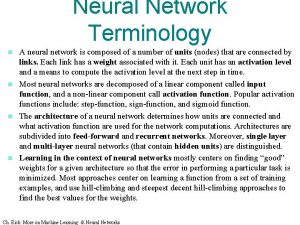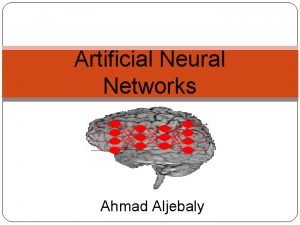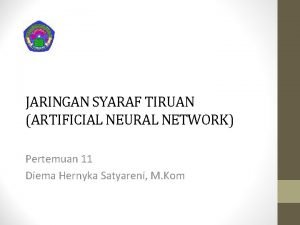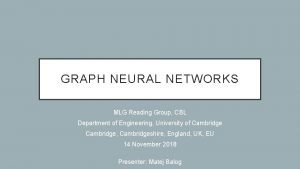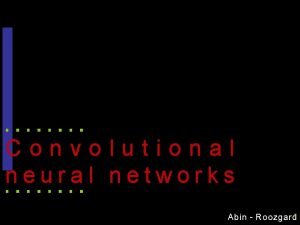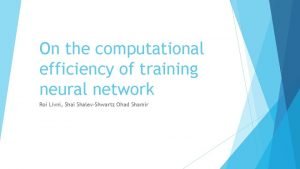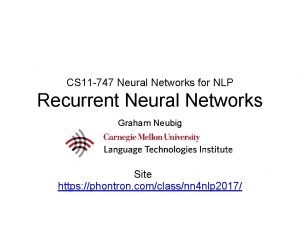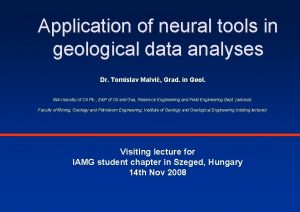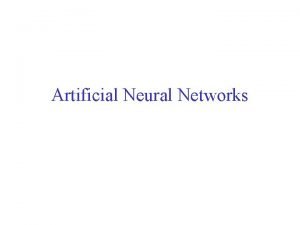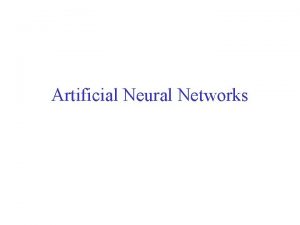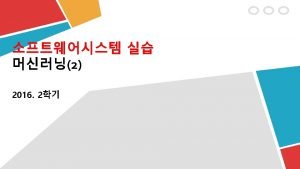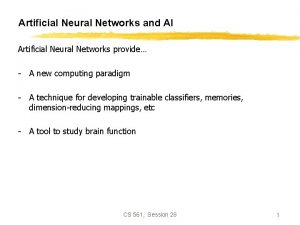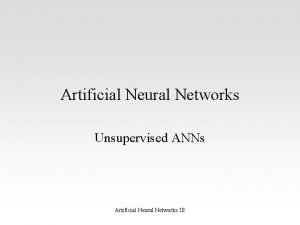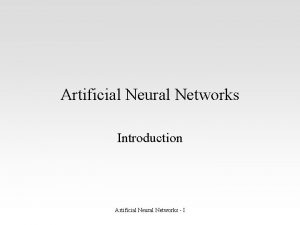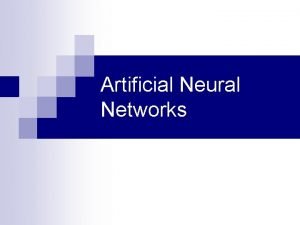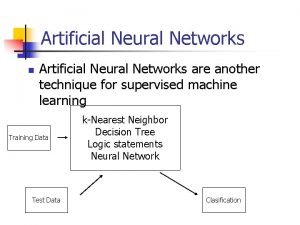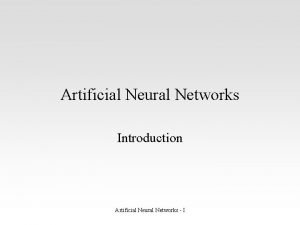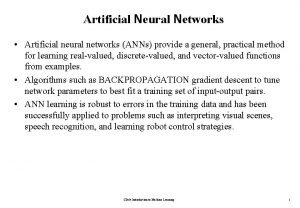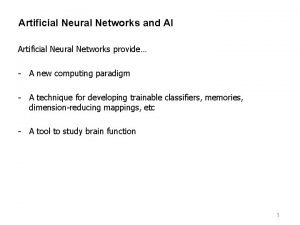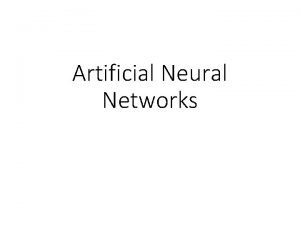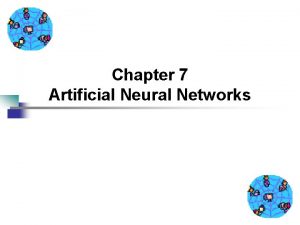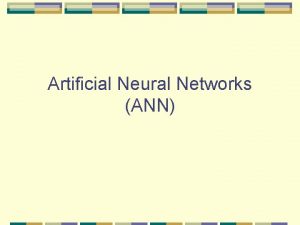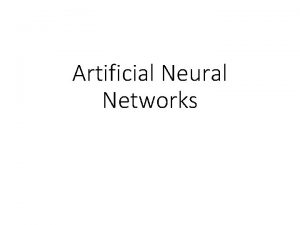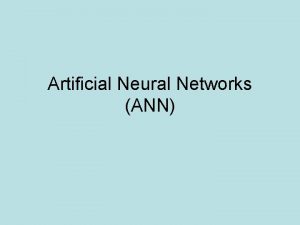Lecture 16 Artificial Neural Networks Discussion 3 of







![Unsupervised Learning: Kohonen’s Self-Organizing Map (SOM) [1] • Another Clustering Algorithm – aka Self-Organizing Unsupervised Learning: Kohonen’s Self-Organizing Map (SOM) [1] • Another Clustering Algorithm – aka Self-Organizing](https://slidetodoc.com/presentation_image/9e016d69d350a79ef19e2b5225c0b3fa/image-8.jpg)
![Unsupervised Learning: Kohonen’s Self-Organizing Map (SOM) [2] • Kohonen Network (SOM) for Clustering – Unsupervised Learning: Kohonen’s Self-Organizing Map (SOM) [2] • Kohonen Network (SOM) for Clustering –](https://slidetodoc.com/presentation_image/9e016d69d350a79ef19e2b5225c0b3fa/image-9.jpg)
![Unsupervised Learning: Kohonen’s Self-Organizing Map (SOM) [3] • Traditional Competitive Learning • Only train Unsupervised Learning: Kohonen’s Self-Organizing Map (SOM) [3] • Traditional Competitive Learning • Only train](https://slidetodoc.com/presentation_image/9e016d69d350a79ef19e2b5225c0b3fa/image-10.jpg)








- Slides: 18

Lecture 16 Artificial Neural Networks Discussion (3 of 4): Unsupervised Learning and Pattern Recognition Wednesday, February 23, 2000 William H. Hsu Department of Computing and Information Sciences, KSU http: //www. cis. ksu. edu/~bhsu Readings: “The Wake-Sleep Algorithm for Unsupervised Neural Networks”, Hinton et al (Reference) Section 6. 12, Mitchell (Reference) Section 3. 2. 4 -3. 2. 5, Shavlik and Dietterich CIS 830: Advanced Topics in Artificial Intelligence Kansas State University Department of Computing and Information Sciences

Lecture Outline • Readings: “The Wake-Sleep Algorithm”, Hinton et al • Suggested Reading: 6. 12, Mitchell; Rumelhart and Zipser; Kohonen • This Week’s Reviews: Wake-Sleep, Hierarchical Mixtures of Experts • Unsupervised Learning and Clustering – Definitions and framework – Constructive induction • Feature construction • Cluster definition – EM, Auto. Class, Principal Components Analysis, Self-Organizing Maps • Expectation-Maximization (EM) Algorithm – More on EM and Bayesian Learning – EM and unsupervised learning • Next Lecture: Time Series Learning – Intro to time series learning, characterization; stochastic processes – Read Chapter 19, Russell and Norvig (neural and Bayesian computation) CIS 830: Advanced Topics in Artificial Intelligence Kansas State University Department of Computing and Information Sciences

Unsupervised Learning: Objectives • Unsupervised Learning – Given: data set D x Supervised Learning f(x) x Unsupervised Learning y • Vectors of attribute values (x 1, x 2, …, xn) • No distinction between input attributes and output attributes (class label) – Return: (synthetic) descriptor y of each x • Clustering: grouping points (x) into inherent regions of mutual similarity • Vector quantization: discretizing continuous space with best labels • Dimensionality reduction: projecting many attributes down to a few • Feature extraction: constructing (few) new attributes from (many) old ones • Intuitive Idea – Want to map independent variables (x) to dependent variables (y = f(x)) – Don’t always know what “dependent variables” (y) are – Need to discover y based on numerical criterion (e. g. , distance metric) CIS 830: Advanced Topics in Artificial Intelligence Kansas State University Department of Computing and Information Sciences

Clustering • A Mode of Unsupervised Learning – Given: a collection of data points – Goal: discover structure in the data • Organize data into sensible groups (how many here? ) • Criteria: convenient and valid organization of the data • NB: not necessarily rules for classifying future data points – Cluster analysis: study of algorithms, methods for discovering this structure • Representing structure: organizing data into clusters (cluster formation) • Describing structure: cluster boundaries, centers (cluster segmentation) • Defining structure: assigning meaningful names to clusters (cluster labeling) • Cluster: Informal and Formal Definitions – Set whose entities are alike and are different from entities in other clusters – Aggregation of points in the instance space such that distance between any two points in the cluster is less than the distance between any point in the cluster and any point not in it CIS 830: Advanced Topics in Artificial Intelligence Kansas State University Department of Computing and Information Sciences

Quick Review: Bayesian Learning and EM • Problem Definition – Given: data (n-tuples) with missing values, aka partially observable (PO) data – Want to fill in ? with expected value • Solution Approaches – Expected = distribution over possible values – Use “best guess” Bayesian model (e. g. , BBN) to estimate distribution – Expectation-Maximization (EM) algorithm can be used here • Intuitive Idea – Want to find h. ML in PO case (D unobserved variables observed variables) – Estimation step: calculate E[unobserved variables | h], assuming current h – Maximization step: update wijk to maximize E[lg P(D | h)], D all variables CIS 830: Advanced Topics in Artificial Intelligence Kansas State University Department of Computing and Information Sciences

EM for Unsupervised Learning • Unsupervised Learning Problem – Objective: estimate a probability distribution with unobserved variables – Use EM to estimate mixture policy (more on this later; see 6. 12, Mitchell) • Pattern Recognition Examples – Human-computer intelligent interaction (HCII) • Detecting facial features in emotion recognition • Gesture recognition in virtual environments – Computational medicine [Frey, 1998] • Determining morphology (shapes) of bacteria, viruses in microscopy • Identifying cell structures (e. g. , nucleus) and shapes in microscopy – Other image processing – Many other examples (audio, speech, signal processing; motor control; etc. ) • Inference Examples – Plan recognition: mapping from (observed) actions to agent’s (hidden) plans – Hidden changes in context: e. g. , aviation; computer security; MUDs CIS 830: Advanced Topics in Artificial Intelligence Kansas State University Department of Computing and Information Sciences

Unsupervised Learning: Competitive Learning for Feature Discovery • Intuitive Idea: Competitive Mechanisms for Unsupervised Learning – Global organization from local, competitive weight update • Basic principle expressed by Von der Malsburg • Guiding examples from (neuro)biology: lateral inhibition – Previous work: Hebb, 1949; Rosenblatt, 1959; Von der Malsburg, 1973; Fukushima, 1975; Grossberg, 1976; Kohonen, 1982 • A Procedural Framework for Unsupervised Connectionist Learning – Start with identical (“neural”) processing units, with random initial parameters – Set limit on “activation strength” of each unit – Allow units to compete for right to respond to a set of inputs • Feature Discovery – Identifying (or constructing) new features relevant to supervised learning – Examples: finding distinguishable letter characteristics in handwriten character recognition (HCR), optical character recognition (OCR) – Competitive learning: transform X into X’; train units in X’ closest to x CIS 830: Advanced Topics in Artificial Intelligence Kansas State University Department of Computing and Information Sciences
![Unsupervised Learning Kohonens SelfOrganizing Map SOM 1 Another Clustering Algorithm aka SelfOrganizing Unsupervised Learning: Kohonen’s Self-Organizing Map (SOM) [1] • Another Clustering Algorithm – aka Self-Organizing](https://slidetodoc.com/presentation_image/9e016d69d350a79ef19e2b5225c0b3fa/image-8.jpg)
Unsupervised Learning: Kohonen’s Self-Organizing Map (SOM) [1] • Another Clustering Algorithm – aka Self-Organizing Feature Map (SOFM) – Given: vectors of attribute values (x 1, x 2, …, xn) – Returns: vectors of attribute values (x 1’, x 2’, …, xk’) • Typically, n >> k (n is high, k = 1, 2, or 3; hence “dimensionality reducing”) • Output: vectors x’, the projections of input points x; also get P(xj’ | xi) • Mapping from x to x’ is topology preserving • Topology Preserving Networks – Intuitive idea: similar input vectors will map to similar clusters – Recall: informal definition of cluster (isolated set of mutually similar entities) – Restatement: “clusters of X (high-D) will still be clusters of X’ (low-D)” • Representation of Node Clusters – Group of neighboring artificial neural network units (neighborhood of nodes) – SOMs: combine ideas of topology-preserving networks, unsupervised learning • Implementation: http: //www. cis. hut. fi/nnrc/ and MATLAB NN Toolkit CIS 830: Advanced Topics in Artificial Intelligence Kansas State University Department of Computing and Information Sciences
![Unsupervised Learning Kohonens SelfOrganizing Map SOM 2 Kohonen Network SOM for Clustering Unsupervised Learning: Kohonen’s Self-Organizing Map (SOM) [2] • Kohonen Network (SOM) for Clustering –](https://slidetodoc.com/presentation_image/9e016d69d350a79ef19e2b5225c0b3fa/image-9.jpg)
Unsupervised Learning: Kohonen’s Self-Organizing Map (SOM) [2] • Kohonen Network (SOM) for Clustering – Training algorithm: unnormalized competitive learning – Map is organized as a grid (shown here in 2 D) • Each node (grid element) has a weight vector wj • Dimension of wj is n (same as input vector) x’ : vector in 2 -space x : vector in n-space • Number of trainable parameters (weights): m · n for an m-by-m SOM • 1999 state-of-the-art: typical small SOMs 5 -20, “industrial strength” > 20 – Output found by selecting j* whose wj has minimum Euclidean distance from x • Only one active node, aka Winner-Take-All (WTA): winning node j* • i. e. , j* = arg minj || wj - x ||2 • Update Rule • Same as competitive learning algorithm, with one modification • Neighborhood function associated with j* spreads the wj around CIS 830: Advanced Topics in Artificial Intelligence Kansas State University Department of Computing and Information Sciences
![Unsupervised Learning Kohonens SelfOrganizing Map SOM 3 Traditional Competitive Learning Only train Unsupervised Learning: Kohonen’s Self-Organizing Map (SOM) [3] • Traditional Competitive Learning • Only train](https://slidetodoc.com/presentation_image/9e016d69d350a79ef19e2b5225c0b3fa/image-10.jpg)
Unsupervised Learning: Kohonen’s Self-Organizing Map (SOM) [3] • Traditional Competitive Learning • Only train j* j* • Corresponds to neighborhood of 0 • Neighborhood of 1 Neighborhood Function hj, j* – For 2 D Kohonen SOMs, h is typically a square or hexagonal region • j*, the winner, is at the center of Neighborhood (j*) • hj*, j* 1 – Nodes in Neighborhood (j) updated whenever j wins, i. e. , j* = j – Strength of information fed back to wj is inversely proportional to its distance from the j* for each x – Often use exponential or Gaussian (normal) distribution on neighborhood to decay weight delta as distance from j* increases • Annealing of Training Parameters – Neighborhood must shrink to 0 to achieve convergence – r (learning rate) must also decrease monotonically CIS 830: Advanced Topics in Artificial Intelligence Kansas State University Department of Computing and Information Sciences

Unsupervised Learning: SOM and Other Projections for Clustering Dimensionality. Reducing Projection (x’) Clusters of Similar Records Delaunay Triangulation Voronoi (Nearest Neighbor) Diagram (y) Cluster Formation and Segmentation Algorithm (Sketch) CIS 830: Advanced Topics in Artificial Intelligence Kansas State University Department of Computing and Information Sciences

Unsupervised Learning: Other Algorithms (PCA, Factor Analysis) • Intuitive Idea – Q: Why are dimensionality-reducing transforms good for supervised learning? – A: There may be many attributes with undesirable properties, e. g. , • Irrelevance: xi has little discriminatory power over c(x) = yi • Sparseness of information: “feature of interest” spread out over many xi’s (e. g. , text document categorization, where xi is a word position) • We want to increase the “information density” by “squeezing X down” • Principal Components Analysis (PCA) – Combining redundant variables into a single variable (aka component, or factor) – Example: ratings (e. g. , Nielsen) and polls (e. g. , Gallup); responses to certain questions may be correlated (e. g. , “like fishing? ” “time spent boating”) • Factor Analysis (FA) – General term for a class of algorithms that includes PCA – Tutorial: http: //www. statsoft. com/textbook/stfacan. html CIS 830: Advanced Topics in Artificial Intelligence Kansas State University Department of Computing and Information Sciences

Clustering Methods: Design Choices • Intuition – Functional (declarative) definition: easy (“We recognize a cluster when we see it”) – Operational (procedural, constructive) definition: much harder to give – Possible reason: clustering of objects into groups has taxonomic semantics (e. g. , shape, size, time, resolution, etc. ) • Possible Assumptions – Data generated by a particular probabilistic model – No statistical assumptions • Design Choices – Distance (similarity) measure: standard metrics, transformation-invariant metrics • L 1 (Manhattan): |xi - yi|, L 2 (Euclidean): , L (Sup): max |xi - yi| • Symmetry: Mahalanobis distance • Shift, scale invariance: covariance matrix – Transformations (e. g. , covariance diagonalization: rotate axes to get rotational invariance, cf. PCA, FA) CIS 830: Advanced Topics in Artificial Intelligence Kansas State University Department of Computing and Information Sciences

Clustering: Applications Data from T. Mitchell’s web site: http: //www. cs. cmu. edu/~tom/faces. html NCSA D 2 K 1. 0 - http: //www. ncsa. uiuc. edu/STI/ALG/ http: //www. cnl. salk. edu/~wiskott/Bibliographies/ Face. Feature. Finding. html Transactional Database Mining 6500 news stories from the WWW in 1997 Theme. Scapes - http: //www. cartia. com Facial Feature Extraction Confidential and proprietary to Caterpillar; may only be used with prior written consent from Caterpillar. Information Retrieval: Text Document Categorization NCSA D 2 K 2. 0 - http: //www. ncsa. uiuc. edu/STI/ALG/ CIS 830: Advanced Topics in Artificial Intelligence Kansas State University Department of Computing and Information Sciences

Unsupervised Learning and Constructive Induction • Unsupervised Learning in Support of Supervised Learning – Given: D labeled vectors (x, y) Constructive Induction – Return: D’ transformed training examples (x’, y’) (x, y) – Solution approach: constructive induction Feature (Attribute) Construction and Partitioning • Feature “construction”: generic term • Cluster definition • x’ / (x 1’, …, xp’) Feature Construction: Front End – Synthesizing new attributes Cluster Definition • Logical: x 1 x 2, arithmetic: x 1 + x 5 / x 2 • Other synthetic attributes: f(x 1, x 2, …, xn), etc. – Dimensionality-reducing projection, feature extraction (x’, y’) or ((x 1’, y 1’), …, (xp’, yp’)) – Subset selection: finding relevant attributes for a given target y – Partitioning: finding relevant attributes for given targets y 1, y 2, …, yp • Cluster Definition: Back End – Form, segment, and label clusters to get intermediate targets y’ – Change of representation: find an (x’, y’) that is good for learning target y CIS 830: Advanced Topics in Artificial Intelligence Kansas State University Department of Computing and Information Sciences

Clustering: Relation to Constructive Induction • Clustering versus Cluster Definition – Clustering: 3 -step process – Cluster definition: “back end” for feature construction • Clustering: 3 -Step Process – Form • (x 1’, …, xk’) in terms of (x 1, …, xn) • NB: typically part of construction step, sometimes integrates both – Segment • (y 1’, …, y. J’) in terms of (x 1’, …, xk’) • NB: number of clusters J not necessarily same as number of dimensions k – Label • Assign names (discrete/symbolic labels (v 1’, …, v. J’)) to (y 1’, …, y. J’) • Important in document categorization (e. g. , clustering text for info retrieval) • Hierarchical Clustering: Applying Clustering Recursively CIS 830: Advanced Topics in Artificial Intelligence Kansas State University Department of Computing and Information Sciences

Terminology • Expectation-Maximization (EM) Algorithm – Iterative refinement: repeat until convergence to a locally optimal label – Expectation step: estimate parameters with which to simulate data – Maximization step: use simulated (“fictitious”) data to update parameters • Unsupervised Learning and Clustering – Constructive induction: using unsupervised learning for supervised learning • Feature construction: “front end” - construct new x values • Cluster definition: “back end” - use these to reformulate y – Clustering problems: formation, segmentation, labeling – Key criterion: distance metric (points closer intra-cluster than inter-cluster) – Algorithms • Auto. Class: Bayesian clustering • Principal Components Analysis (PCA), factor analysis (FA) • Self-Organizing Maps (SOM): topology preserving transform (dimensionality reduction) for competitive unsupervised learning CIS 830: Advanced Topics in Artificial Intelligence Kansas State University Department of Computing and Information Sciences

Summary Points • Expectation-Maximization (EM) Algorithm • Unsupervised Learning and Clustering – Types of unsupervised learning • Clustering, vector quantization • Feature extraction (typically, dimensionality reduction) – Constructive induction: unsupervised learning in support of supervised learning • Feature construction (aka feature extraction) • Cluster definition – Algorithms • EM: mixture parameter estimation (e. g. , for Auto. Class) • Auto. Class: Bayesian clustering • Principal Components Analysis (PCA), factor analysis (FA) • Self-Organizing Maps (SOM): projection of data; competitive algorithm – Clustering problems: formation, segmentation, labeling • Next Class: Presentation on Modular and Hierarchical ANNs CIS 830: Advanced Topics in Artificial Intelligence Kansas State University Department of Computing and Information Sciences
 Neural network terminology
Neural network terminology Conclusion neural network
Conclusion neural network Pengertian artificial neural network
Pengertian artificial neural network Artificial neural network in data mining
Artificial neural network in data mining Graph neural network lecture
Graph neural network lecture Predicting nba games using neural networks
Predicting nba games using neural networks Convolutional neural networks
Convolutional neural networks Convolutional neural networks for visual recognition
Convolutional neural networks for visual recognition On the computational efficiency of training neural networks
On the computational efficiency of training neural networks Convolutional neural network
Convolutional neural network Convolutional neural network alternatives
Convolutional neural network alternatives Convolutional neural networks
Convolutional neural networks Liran szlak
Liran szlak 11-747 neural networks for nlp
11-747 neural networks for nlp Leon gatys
Leon gatys Neural networks and learning machines
Neural networks and learning machines Neuraltools neural networks
Neuraltools neural networks Input layer
Input layer Pixel recurrent neural networks.
Pixel recurrent neural networks.
